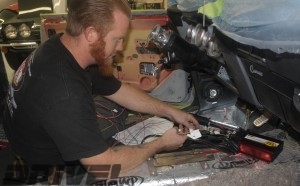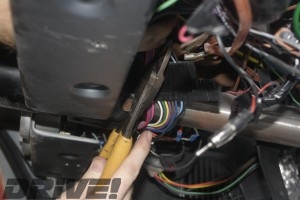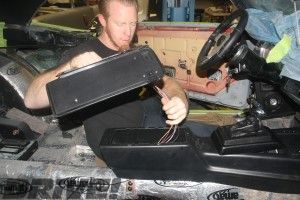Paddle as Fast as You Can: Installing TCI’s 6X Six-Speed Transmission and Paddle Shifter
Text and Photos by Matt Emery
Paddle as Fast as You Can: Installing TCI’s 6X Six-Speed Transmission and Paddle Shifter
Automatic transmissions have been around nearly as long as the automobile. They served their purpose, but for those who were looking for performance, the manual gearbox was the way to go. And the more gears in that box the better. Even though high gear is traditionally a 1:1 setup, having many gears to choose from makes keeping the engine in the meat of the power band that much easier. The “three on the tree” became a four, then five, and finally six speeds capable of handling whatever the driver/racer asked of it. Of course, this was all via a floor-mounted shifter usually using an “H” pattern.
We believe that it was former multi-world-champion Nigel Mansell who way back in the mid ‘90s had the first working paddle shift setup in his F1 Ferrari. Some say that the idea of shifting the car from the steering wheel has been around since the very early days of racing (like 1912 Le Mans early), but everyone was blown away with the concept, especially when Mansell won the first race in which the new paddle shifted semi-automatic transmission was used. Despite some glitches, it proved to be the death knell of the fully manual gearbox, which was gone from F1 for good only a year or two later. Racing proved that to be a good idea. The automatic transmission could be made even better, and more importantly, strong enough to put up with high performance engines and the rigors of racing.
Enter TCI Automotive. With its 6X six-speed transmission, TCI has taken the best ideas of both and combined them into one unit that gives the competition focused muscle car enthusiast what is nearly an unfair advantage when it comes to autocrossing. Gone is the “gear hunting” of some automatics and gone also is the need to operate a clutch coming out of a corner. Shifting through a corner is an art, but imagine having the ability to keep the engine in the perfect rev range no matter what part of the course you’re on? Setting up for corners are no longer a problem and downshifting for them no longer requires taking your hands off the wheel. Shifting into or out of them is now a matter of how quickly you can pull a paddle.
The installation of the TCI 6X is two-fold: the tranny, which is much like installing any other trans, and the electronic/electrical systems to get the tranny and paddles to work. Luckily, TCI supplies some very detailed instructions on how to do the job, but this owner made it even easier. He had The 401K Club in Anaheim, California, do the job for him. We watched as the crew at 401 tackled the job and came away thinking that someone with a good knowledge of mechanics could do this at home. When we say “good,” we don’t mean that you can change your own plugs, but that you have the ability, tools and space to change out a transmission and do not just outrageously difficult, but complex, wiring, too.
If this is describes you, and you want what amounts to an unfair advantage (is there such a thing in racing?) when autocrossing, then maybe you should take a good long look at the TCI Automotive 6X six-speed transmission.
TCI AUTOMOTIVE
151 Industrial Dr.
Ashland, Miss. 38603
888.776.9824
www.tciauto.com
THE 401K CLUB
4392 E. La Palma Ave.
Anaheim, CA 92807
714.993.4015
www.the401kclub.com
The new TCI 6X six-speed transmission employs the best ideas of everything from Formula 1 to super high-end sports cars. A rugged six-speed, semi-automatic transmission that is capable of being shifted electronically from steering wheel-mounted paddles is revolutionary for muscle cars.
Out with the old, so they say. In this case the old was a Turbo 400. The TH400 is a good tranny, but the owner wants to put this Camaro through a road course at the limits of its capabilities. The problem is that the 400 was one of those limits.
There is some prep involved with getting the new TCI unit ready to install. Once Teflon tape has been applied to the threads, the fittings for the cooler lines are installed
A quart or so of fluid is fed into the TCI converter prior to installation.
It takes a good touch to get the converter fully bottomed out, but care needs to be taken to ensure that it is fully bottomed out or the converter will not work properly.
Installing the upper bolts sure is easier with the car up on a lift and having a long extension for the pneumatic gun. But this job can be done on a garage floor using a tranny jack, just not as comfortably.
The tranny cross member is bolted in place.
A few drops of LocTite are placed on the converter bolts before being installed and torqued to specs. Don’t forget this step, or the bolts may (but always seem to) work loose.
A special wrench is nice to have when spinning the converter, thus allowing easy access to the bolt holes in the converter.
The old shifter is removed. It will be replaced with a new one.
The harness is laid out before routing to ensure that everything is going in the right direction prior to attempting install.
An existing hole on top of the tunnel was used to feed the leads down to the transmission. The car is raised using the lift.
The main harness connector plug is connected.
Two other connections are made to the trans. One is the TISS (transmission input speed sensor) and the other is the TOSS, yep, the transmission output speed sensor.
Since the car was up on the lift, and it has to be done sometime, the shift cable bracket and cable are run.
After carefully running the cables up and over the transmission, the lines are fed up to the engine compartment. You have to give it to TCI, they give you plenty (and we mean plenty) of wire.
The lead for the throttle-positioning sensor is connected. For those with a carbureted engine, TCI makes a remote mount TPS that attaches to the carb.
With the tranny and engine connections made, the remaining wires are again separated and itemized. There are a lot of wires going a lot of different places, so keeping them literally and figuratively straight is a must.
With the MOMO steering wheel removed from its mount, the TCI
The TCI paddle shifter is sandwiched between the wheel and the mount using the supplied hardware.
A good ground is very important to everything, so a lug is attached to the steering column.
Wiring up the paddle shifter begins with finding the electrical connection for the steering wheel. TCI supplies a detailed schematics and instruction sheet to make this simple. Well, as simple as wiring can be, anyway.
The leads from the horn switch and relay are connected to wires that lead back to the main harness connector plug and the paddle shifter receiver module.
This is the paddle shifter receiver module. Connections are made easy with a simple plug in situation.
The new B&M hammer shifter also takes its place in the console.
As the unit is not “hot” at all times, it takes a button to energize the paddle shifter feature, so one works the paddles while the other can place the trans in “manual” shifting mode. The 401K Club wanted things to be clean, so these buttons were mounted onto a plate that is inside the center console.
The new B&M hammer shifter and the activation buttons are clean and under the driver’s fingertips.
With the MOMO steering wheel back together, the job is done and the trick new TCI paddle shifter and B&M hammer floor shifter are ready to take the driver to newfound heights of fun.






























